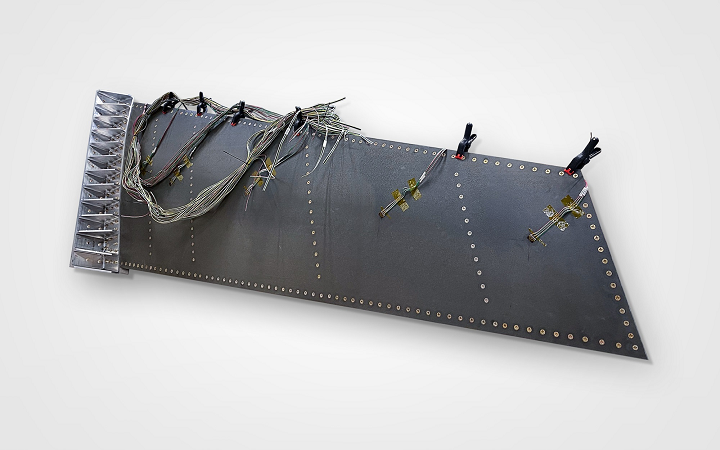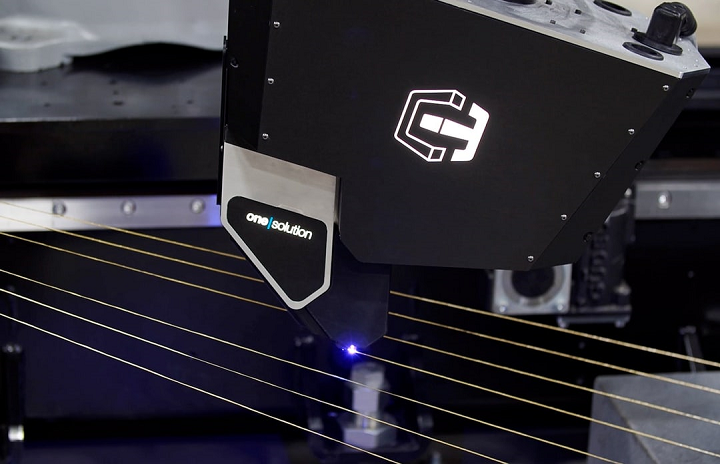Idaho-based company Continuous Composites owns the earliest granted patents on Continuous Fiber 3D Printing, or CF3D, which can reduce manufacturing lead time and manual labor and enable the production of complex geometries. The company just announced that its CF3D technology was used to complete a two-year Wing Structure Design for Manufacturing (WiSDM) contract for the Air Force Research Laboratory (AFRL) through Lockheed Martin (NYSE: LMT). The project, with an end goal of manufacturing a Low Cost Attritable Aircraft (LCAA) wing, was extremely successful, as Continuous Composites reports that the carbon fiber 3D printed wing spars demonstrated a structural performance to “160% design limit load.”
“The successful work with Continuous Composites and AFRL’s focus on CF3D® for this project not only advances new 3D printing technology but also offers the potential for aerospace-grade composite printing in high-performance industries. We recognize this process is paving the way for broader applications within both defense and commercial applications, and Lockheed Martin plans to be part of that future of advanced manufacturing,” John Scarcello, Senior Manager, Lockheed Martin Skunk Works®, said in a press release.
The focus of the WiSDM contract and LCAA project was to majorly decrease the lead time and cost of building attritable airframe structures, by using a new structural design framework and corresponding manufacturing and materials; that’s why CF3D was chosen to print the wing assembly’s structural carbon fiber spars. However, several other manufacturing technologies were also used during the program, including:
- long fiber injection molding for the ribs
- automated fiber replacement for skins
- 3D printed tooling
- autodrill and robotic assembly
Continuous Composites’ CF3D technology was used to print two carbon fiber tapered C-channel spars, each weighing four pounds and measuring eight feet long.
“CF3D® presents an innovative manufacturing technology that shows great promise to be both low cost and agile to the production rate and responsiveness requirements to realize attritable airframe structures,” said Ray Fisher, Air Force Research Laboratory Program Manager. “The success of this LCAA project shows great opportunity for additive manufacturing with customized CF3D® material solutions that can orient structural fibers optimally. It is especially attractive to avoid expensive tooling in manufacturing aerospace structural parts. I look forward to additional opportunities to incorporate CF3D® in increasingly complex structures that are further optimized for attritable enabling production.”
CF3D is, according to Continuous Composites, a “novel approach to composites manufacturing,” and is a fully automated, configurable process. A continuous dry fiber is impregnated in situ with a snap-curing, thermosetting resin delivered by an end effector, which is moved by a software-driven motion platform; to allow for variable part thickness and ply drops in the resulting structure, cutting and feeding are also used. Parts are precisely printed, and optimized for high performance with the continuous fibers, which then leads to the cost and lead time savings.
“This project is one application where CF3D® showcases the significant cost reduction and design freedom while exceeding the stringent mechanical properties required for aerospace. Our team is very appreciative to Lockheed Martin, the U.S. Air Force, and other partners for including CF3D® in this LCAA project. We are taking the next steps to select our long-term DoD prime partner while engaging the Air Force as evidenced by the upcoming announcements of our key involvement with AFRL PiCARD program in parallel to a five-year CRADA,” said Continuous Composites’ CEO Tyler Alvarado.
The final wing assembly delivered to the United States Air Force, where it was statistically load tested. The fully assembled wing gave a stellar performance: before the compression skin buckled, it achieved 160% design limit load (DLL). The 3D printed spars held, with no measured or visual damage, which demonstrated the component’s structural performance. Finally, the CF3D-fabricated carbon fiber spars were able to achieve a 60% fiber volume fraction with approximately 1% to 2% voids.
Subscribe to Our Email Newsletter
Stay up-to-date on all the latest news from the 3D printing industry and receive information and offers from third party vendors.
Print Services
Upload your 3D Models and get them printed quickly and efficiently.
You May Also Like
Consolidation in AM: How 2025 Is Shaping the Industry’s New Normal
The first half of 2025 has been marked by a clear shift in the additive manufacturing (AM) industry. Companies are no longer just focused on developing new tech by themselves....
Etsy Design Rule Change Reduces Selection of 3D Printed Goods
Online marketplace Etsy has implemented a rule change requiring all 3D printed goods on the site to be original designs. The update to the site’s Creativity Standards states, ¨Items produced using...
U.S. Congress Calls Out 3D Printing in Proposal for Commercial Reserve Manufacturing Network
Last week, the U.S. House of Representatives’ Appropriations Committee moved the FY 2026 defense bill forward to the House floor. Included in the legislation is a $131 million proposal for...
Transforming From Tourist to Native: Duro CEO Michael Corr Explains Why the Company Rebuilt its PLM Software on AI
In these early innings of the AI boom, many market analysts have expressed concern that AI spend has gotten too far ahead of the technology’s proven ability to deliver significant...



































